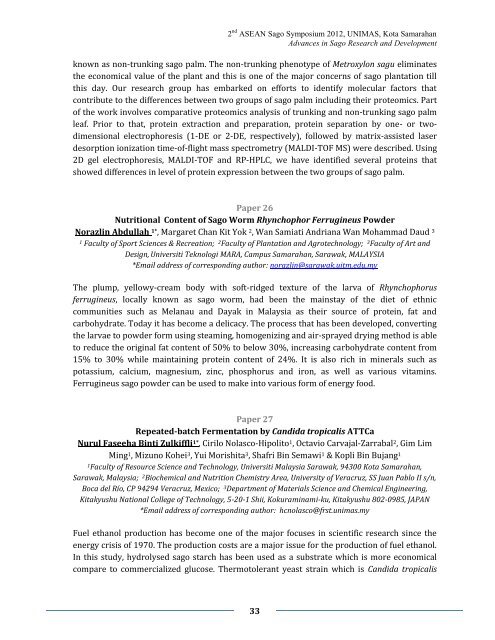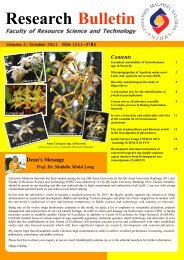2nd ASEAN Sago Symposium 2012, UNIMAS, Kota Samarahan ...
2nd ASEAN Sago Symposium 2012, UNIMAS, Kota Samarahan ...
2nd ASEAN Sago Symposium 2012, UNIMAS, Kota Samarahan ...
You also want an ePaper? Increase the reach of your titles
YUMPU automatically turns print PDFs into web optimized ePapers that Google loves.
2 nd <strong>ASEAN</strong> <strong>Sago</strong> <strong>Symposium</strong> <strong>2012</strong>, <strong>UNIMAS</strong>, <strong>Kota</strong> <strong>Samarahan</strong><br />
Advances in <strong>Sago</strong> Research and Development<br />
known as non-trunking sago palm. The non-trunking phenotype of Metroxylon sagu eliminates<br />
the economical value of the plant and this is one of the major concerns of sago plantation till<br />
this day. Our research group has embarked on efforts to identify molecular factors that<br />
contribute to the differences between two groups of sago palm including their proteomics. Part<br />
of the work involves comparative proteomics analysis of trunking and non-trunking sago palm<br />
leaf. Prior to that, protein extraction and preparation, protein separation by one- or twodimensional<br />
electrophoresis (1-DE or 2-DE, respectively), followed by matrix-assisted laser<br />
desorption ionization time-of-flight mass spectrometry (MALDI-TOF MS) were described. Using<br />
2D gel electrophoresis, MALDI-TOF and RP-HPLC, we have identified several proteins that<br />
showed differences in level of protein expression between the two groups of sago palm.<br />
Paper 26<br />
Nutritional Content of <strong>Sago</strong> Worm Rhynchophor Ferrugineus Powder<br />
Norazlin Abdullah 1*, Margaret Chan Kit Yok 2, Wan Samiati Andriana Wan Mohammad Daud 3<br />
1 Faculty of Sport Sciences & Recreation; 2 Faculty of Plantation and Agrotechnology; 3 Faculty of Art and<br />
Design, Universiti Teknologi MARA, Campus <strong>Samarahan</strong>, Sarawak, MALAYSIA<br />
*Email address of corresponding author: norazlin@sarawak.uitm.edu.my<br />
The plump, yellowy-cream body with soft-ridged texture of the larva of Rhynchophorus<br />
ferrugineus, locally known as sago worm, had been the mainstay of the diet of ethnic<br />
communities such as Melanau and Dayak in Malaysia as their source of protein, fat and<br />
carbohydrate. Today it has become a delicacy. The process that has been developed, converting<br />
the larvae to powder form using steaming, homogenizing and air-sprayed drying method is able<br />
to reduce the original fat content of 50% to below 30%, increasing carbohydrate content from<br />
15% to 30% while maintaining protein content of 24%. It is also rich in minerals such as<br />
potassium, calcium, magnesium, zinc, phosphorus and iron, as well as various vitamins.<br />
Ferrugineus sago powder can be used to make into various form of energy food.<br />
Paper 27<br />
Repeated-batch Fermentation by Candida tropicalis ATTCa<br />
Nurul Faseeha Binti Zulkiffli 1*, Cirilo Nolasco-Hipolito 1, Octavio Carvajal-Zarrabal 2, Gim Lim<br />
Ming 1, Mizuno Kohei 3, Yui Morishita 3, Shafri Bin Semawi 1 & Kopli Bin Bujang 1<br />
1 Faculty of Resource Science and Technology, Universiti Malaysia Sarawak, 94300 <strong>Kota</strong> <strong>Samarahan</strong>,<br />
Sarawak, Malaysia; 2 Biochemical and Nutrition Chemistry Area, University of Veracruz, SS Juan Pablo II s/n,<br />
Boca del Río, CP 94294 Veracruz, Mexico; 3 Department of Materials Science and Chemical Engineering,<br />
Kitakyushu National College of Technology, 5-20-1 Shii, Kokuraminami-ku, Kitakyushu 802-0985, JAPAN<br />
*Email address of corresponding author: hcnolasco@frst.unimas.my<br />
Fuel ethanol production has become one of the major focuses in scientific research since the<br />
energy crisis of 1970. The production costs are a major issue for the production of fuel ethanol.<br />
In this study, hydrolysed sago starch has been used as a substrate which is more economical<br />
compare to commercialized glucose. Thermotolerant yeast strain which is Candida tropicalis<br />
33



